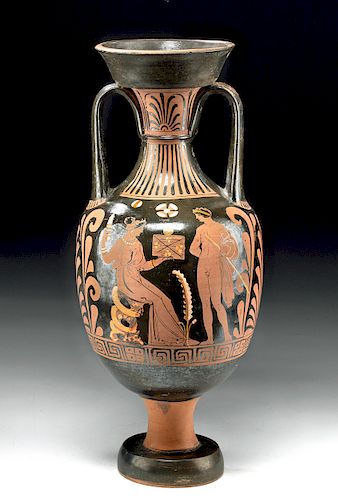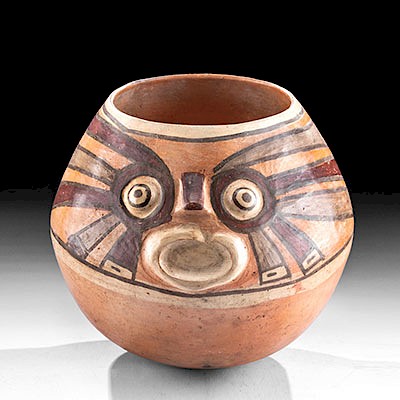Stunning Greek Apulian Amphora w/ TL Report
Lot 16
About Seller
Artemis Gallery
686 S Taylor Ave, Ste 106
Louisville, CO 80027
United States
Selling antiquities, ancient and ethnographic art online since 1993, Artemis Gallery specializes in Classical Antiquities (Egyptian, Greek, Roman, Near Eastern), Asian, Pre-Columbian, African / Tribal / Oceanographic art. Our extensive inventory includes pottery, stone, metal, wood, glass and textil...Read more
Categories
Estimate:
$12,000 - $18,000
Absentee vs Live bid
Two ways to bid:
- Leave a max absentee bid and the platform will bid on your behalf up to your maximum bid during the live auction.
- Bid live during the auction and your bids will be submitted real-time to the auctioneer.
Bid Increments
| Price | Bid Increment |
|---|---|
| $0 | $25 |
| $300 | $50 |
| $1,000 | $100 |
| $2,000 | $250 |
| $5,000 | $500 |
| $10,000 | $1,000 |
| $20,000 | $2,500 |
| $50,000 | $5,000 |
| $100,000 | $10,000 |
| $200,000 | $20,000 |
About Auction
By Artemis Gallery
Dec 5, 2019
Set Reminder
2019-12-05 10:00:00
2019-12-05 10:00:00
America/New_York
Bidsquare
Bidsquare : Ancient / Ethnographic - Holiday Edition
https://www.bidsquare.com/auctions/artemis-gallery/ancient-ethnographic---holiday-edition-4710
What to give this holiday season? Ancient & Ethnographic Art of course! Our special Holiday auction features hundreds of unique finds from all over the world. Artemis Gallery info@artemisgallery.com
What to give this holiday season? Ancient & Ethnographic Art of course! Our special Holiday auction features hundreds of unique finds from all over the world. Artemis Gallery info@artemisgallery.com
- Lot Description
Magna Graecia, Southern Italy, Apulia, ca. 350 to 300 BCE. A very large Apulian amphora, its generous surface area extensively painted via the red-figure technique with added fugitive yellow/white pigment - featuring Dionysian (Bacchic) scenes, quite apropos as this vessel may have stored wine. Side A presents a feminine maenad, draped in a flowing garment and bedecked with armlets, a beaded necklace, and drop earring as well as a saccos over her upswept coiffure. She sits upon a rocky outcrop, her body in composite profile, holding a casket in her outstretched left hand (presenting it to young Dionysos) and a flower in a vessel in her raised right hand. Standing before her is a nude male, likely young Dionysos, his cloak draped over his right arm, and holding a staff in his right hand. Side B features a pair of opposing draped figures, one leaning upon a walking stick. Size: 7.375" in diameter x 17.375" H (18.7 cm x 44.1 cm)
In addition to this figural iconography, the decorative program is quite impressive, featuring elaborate composite palmettes beneath each handle, stylized palmettes adorning the underside of the rim, and a register of Greek key motifs with four dotted checkerboard motifs below the figural scenes and palmettes.
Perhaps the most exciting innovation in Greek vase painting was the red-figure technique, invented in Athens around 525 BCE and beloved by other artists of Magna Graecia. The red-figure technique allowed for much greater flexibility as opposed to the black-figure technique, for now the artist could use a soft, pliable brush rather than a rigid metal graver to delineate interior details, play with the thickness of the lines, as well as build up or dilute glazes to create chromatic effects. The painter would create figures by outlining them in the natural red of the vase, and then enrich these figural forms with black lines to suggest volume, at times perspectival depth, and movement, bringing those silhouettes and their environs to life. Beyond this, fugitive pigments made it possible for the artist to create additional layers of interest and detail as we see in this example.
This piece has been tested using thermoluminescence (TL) analysis and has been found to be ancient and of the period stated. A full report will accompany purchase.
Provenance: private J.H. collection, Beaverton, Oregon, USA; ex-Ancient Art: The Gallery, London
All items legal to buy/sell under U.S. Statute covering cultural patrimony Code 2600, CHAPTER 14, and are guaranteed to be as described or your money back.
A Certificate of Authenticity will accompany all winning bids.
We ship worldwide and handle all shipping in-house for your convenience.
#149626Tiny TL holes under rim and foot. Slight surface wear with minor scuffs and areas of pigment loss. Otherwise intact and superb. Black glaze has developed a marvelous silvery iridescence in areas.Condition
- Shipping Info
-
All shipping is handled in-house for your convenience. Your invoice from Artemis Gallery will include shipping calculation instructions. If in doubt, please inquire BEFORE bidding for estimated shipping costs for individual items.
-
- Buyer's Premium



 EUR
EUR CAD
CAD AUD
AUD GBP
GBP MXN
MXN HKD
HKD CNY
CNY MYR
MYR SEK
SEK SGD
SGD CHF
CHF THB
THB
















